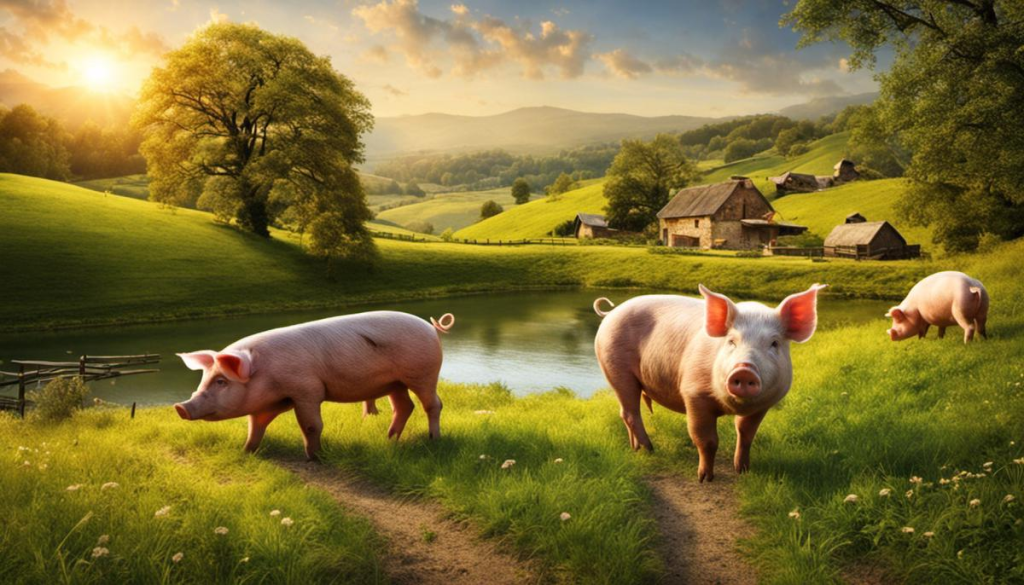Steeped in history and wrought with symbolism, pigs have held a diverse array of roles across cultures from ancient societies to the present day. These intelligent creatures have been heralded as sacred in certain religions, while others see them as a taboo. Through festivities and celebrations, they’ve been lavished with symbolism and their presence has become an inextricable aspect of numerous cultural traditions. As versatile resources, pigs have also played a key culinary role worldwide, with the preparations and consumption of pork often holding significant meaning. Yet, as society evolves, so too do the cultural perspectives on pigs, swayed by fresh ethical, environmental, and health considerations. In this expedition through different epochs and cultures, we will immerse ourselves in the rich milieu of pig-related customs and beliefs, exploring their deep historical roots and their dynamic modern realizations.

Historical Importance of Pigs
Historical Domestication of Pigs
The domestication of pigs is believed to have started around 9,000 years ago in the Near East, China, and Europe. Wild boars are taken to be the ancestral stock of domestic pigs. In these regions, early human settlers started capturing young wild boars and bred them for characteristics that were beneficial for their survival such as size, docility, and fattening capacity. This marked the birth of pig farming and subsequently, the creation of various pig breeds that we know today.
Pigs as Livestock
Pigs have played vital roles as livestock throughout history. Their versatility and adaptability to varying climatic conditions and feeding habits made them an essential part of agricultural societies. Pigs provided a reliable source of meat, and in some cases, milk. Their hides were used for clothing and their bones and teeth were crafted into tools and ornaments. Cheaper to raise than cows and larger than poultry, pigs offer a balance in terms of efficiency and output, making them widespread livestock across the world.
Pigs in Mythology and Folklore
Pigs hold significant importance in numerous cultures’ mythology and folklore. In ancient Egyptian mythology, the pig was associated with the Sky Goddess Nut and was considered a beneficial creature that helped the crops grow. The Greek mythology also features pigs; Circe, the sorceress, was known to transform her enemies into swine. Celtic mythology includes shape-shifting gods who could become boars, reinforcing the animal’s importance. The pig was also significant in Roman culture; As a sacred animal of the goddess Diana, it was used in sacrifices and rites.
Pigs in Religion
Religion has shaped cultural practices with pigs, often resulting in contrasting views. For instance, in Judaism and Islam, pigs are considered unclean and their consumption is forbidden, consequently influencing cultural practices in regions where these religions are dominant. However, in Christianity, pigs are not subject to such restrictions and pork has become a staple food in many Christian-dominated regions. In Hinduism, the god Vishnu took the form of a boar in one of his avatars, linking pigs to religious narratives.
Pigs in Social Practices
Pigs also figure largely in a number of social practices. In certain rural communities, pig-rearing is seen as a form of savings. Pigs can be sold off in times of financial need, serving as a living investment. In others, particularly in China and Southeast Asia, pigs are often central to feasts and celebrations such as weddings and Lunar New Year. The raising and slaughter of the pig, as well as the distribution of its meat, are often deeply ingrained traditions with social and communal significance.
The Symbolic Significance of Pigs
Pigs have a significant place in the symbolism of various cultures around the world. They often represent traits or ideas such as prosperity, fertility, bravery, and intelligence. For instance, in the Chinese Zodiac, the pig symbolizes wealth and fortune. Similarly, in Scotland, it’s a common belief that pig statues attract good fortune. However, symbolically, pigs also embody negative connotations like laziness and gluttony, primarily due to their perceived sedentary behavior.

Religious Significance of Pigs
The Role of Pigs in Pacific Island Customs
Transitioning from a global perspective to a more regional one, in Pacific Island societies pigs also occupy an eminent position, serving a religious and ceremonial role. Deeply intertwined with traditional Hawaiian culture, pigs are central to rituals, often offered as sacrifices to gods and ancestral spirits. This is linked to the core tenet of the prevalent animistic belief system that views pigs as terrestrial manifestations of divine entities. Similarly, in Samoan culture, pigs are given as ceremonial presents during significant events like funerals, nuptials, and ascension to chieftainship. The size of the gifted pig often correlates directly with the status of the recipient, signifying the grandeur of the gesture.
Pig Veneration in Chinese Culture
In Chinese culture and folklore, pigs symbolize wealth and abundance due to their large litters. As part of the 12-animal zodiac cycle, the pig represents honesty, prosperity, generosity, and hard work. During the Chinese New Year, it’s not uncommon to see pig figurines or pig-themed decorations, symbolizing hopes for a prosperous year ahead. Many traditional Chinese ceremonies, including weddings, funerals, and thanksgiving events, often involve pigs as part of their rituals.
Pigs in Ancient Egyptian Religion
Ancient Egyptians had a complex relationship with pigs. They associated pigs with Set, the god of chaos, deserts, and storms. While pigs were not a part of temple sacrifices like other animals, they were sometimes offered to gods during significant religious festivals. However, pigs were considered impure, and individuals who handled pigs often faced social discriminations.
Pig Taboo in Islam and Judaism
In both Islam and Judaism, pigs hold a strictly taboo status due to religious dietary laws. Followers of these religions are forbidden from eating pork under any circumstances. Islamic laws prohibit the consumption of pork as part of their dietary restrictions known as Halal. Similarly, in Judaism, consuming pork is not permitted as it violates the kosher dietary laws. These religious dietary laws influence cultural practices as pigs are not bred or reared in many Islamic and Jewish communities.
Pigs in Early Christian Traditions
Early Christian societies often linked pigs to vices, dirtiness, and evil, reflecting in biblical narratives where Jesus drives demons into a group of pigs that, as a result, plunge into a lake to drown. This established a marked divide between the sanctified and the unsanctified surrounding pig imagery. However, raising pigs remained a prevalent activity within Christian communities, and it has perpetuated until the present day due to the crucial role pork plays in the culinary traditions of the West.

Photo by mathildelangevin on Unsplash
Pigs in Cultural Festivities and Celebrations
The Historic and Cultural Roles of Pigs
Across eras and cultures, pigs have held a meaningful place in collective traditions, rituals, and celebrations. From the earliest communities to today’s modern societies, pigs have been honored, offered in sacrifice or embraced in joyous festivities, demonstrating their symbolic resonance, practical importance, and cultural significance. Depending on the cultural context, pigs can symbolize everything from abundance and prosperity to fertility and courage.
The Pig on the Lunar New Year
In Eastern Asia, most notably in China and Vietnam, the pig is considered one of the 12 zodiac animals in their lunar calendar. Celebrating the Year of the Pig, which occurs every 12 years, is a major cultural event that honors pigs for their symbolism of wealth and prosperity. During these celebrations, people exchange gifts, decorate their homes with pig imagery, and prepare special meals that often include pork dishes. Pigs made of candy or dough are also a common sight during these festivities.
Role of Pigs in Pacific Islands’ Celebrations
In the Pacific Islands, particularly in Hawaii and some Polynesian cultures, pigs play a crucial role in feasts and religious rituals. The traditional practice of roasting a whole pig during ‘Luau’ celebrations is a significant part of Hawaiian culture. The pig is cooked in an underground oven called an ‘imu’ and is a major highlight of these feasts. These practices demonstrate the pig’s symbolism of abundance and hospitality in Hawaiian culture.
Pig Festivities in Spain
In Spain, the festival ‘La Matanza,’ meaning ‘The Slaughter,’ is an annual event that pays tribute to the pig. It traditionally takes place in the winter months throughout rural Spain. During this festival, families and friends gather to slaughter and butcher a pig, which they have raised throughout the year. This event not only provides meat for the coming months but also showcases the community spirit, respect for animals, and the importance of sustainable farming practices.
Pigs in Native American Culture
In Native American cultures, while bison, deer, and other native animals are more prevalent, pigs introduced by European settlers have also played a part in some tribal customs. For instance, the Cherokee tribe has a history of using pigs for food and ceremonial purposes. The tribe would hold community feasts where pigs were often featured, demonstrating their role in promoting community unity and kinship.
‘Pig Parade’ at the Guinness Cork Jazz Festival
The Irish Guinness Cork Jazz Festival features a unique display of cultural affection towards pigs with the ‘Pig Parade’. In this vibrant spectacle, you’ll find pig-themed floats and costumes enhancing the festival’s festive atmosphere. Pigs hold a symbolic value in Irish culture and folklore, representing prosperity and a dash of mischief.

Photo by anniespratt on Unsplash
Culinary Practices with Pigs
The Role of Pigs in Global Cuisine
Pork, derived from pigs, holds a distinguished place in cuisine across the globe. Countries in Asia, especially China, consume pork heavily due to its versatility and high fat content contributing to flavorful dishes. Foods such as char siu (barbecued pork) and Chinese pork belly stand out as popular choices. Furthermore, China is famous for its cured hams, with Jinhua ham routinely used to enhance the taste of stews and soups.
In Europe too, pork is a cornerstone of many traditional dishes. Spain boasts its Jamón ibérico, a form of cured ham sourced from the Iberian pig breed. In Germany, well-loved foods like bratwurst and schnitzel prominently feature pork. Additionally, Italy utilizes pigs to produce famed meats like Prosciutto di Parma and Salami.
Pig Preparation and Consumption
Different cultures also have varied practices in preparing and consuming pork. In the United States, barbecuing and smoking pork are popular methods, with dishes like pulled pork sandwiches and country-style pork ribs being favorites. Meanwhile, in the Philippines, the iconic Lechon — a whole pig spit-roasted over charcoal — is a common sight in festive gatherings.
Pig as a street food is also popular, notably in Mexico where tacos al pastor, made from spit-grilled pork, are sold in food carts. In Vietnam, bánh mì, a Vietnamese sandwich which often includes pork, is a staple street food.
In some cultures, nearly every part of the pig is used in cooking. Head cheese made from the head of the hog is consumed in parts of Europe and North America. Pig feet are used in the Southern United States and Caribbean to make trotters stew. Pig’s blood, on the other hand, is used in Asian cuisines like in Filipino’s Dinuguan or Korean’s Sundae.
Symbolism of Pig Dishes
Symbolically, pig dishes can have significant meaning in different cultures. In countries like Spain, Italy, and France, the pig slaughter, known as “matanza,” is a centuries-old tradition — a time for communities to come together and prepare cured meats for the winter. Here, pigs symbolize abundance and community solidarity.
In Chinese culture, pork is a symbol of wealth and prosperity. Certain dishes like Dongpo pork are served during special occasions and symbolize a rich and prosperous year ahead. During Chinese New Year, it’s customary to serve a whole roasted pig to symbolize peace and to attract health, wealth, and happiness for the upcoming year.
It’s important to note that in some cultures, due to religious beliefs, pork is avoided. Both Judaism and Islam have dietary laws that prohibit the consumption of pork.
The Vital Role of Pigs in Global Cuisine
Pigs play a critical role in world cuisine, their versatility and adaptability making them an invaluable asset. The distinct flavor of their meat, the richness of their high fat content, along with a wealth of diverse cuts, have ensured a place of importance for pigs across the globe’s culinary practices.

Contemporary Cultural Perspectives on Pigs
Shifting Perspectives on Pigs in Modern Societies
In contemporary culture, attitudes towards pigs are shaped largely by religious beliefs, ethical considerations, and dietary habits. However, the 21st century has seen a significant evolution in these viewpoints. Factors such as health concerns, rising awareness of animal rights, and environmental implications have collectively contributed to a transformation in traditional cultural practices regarding pigs.
Rise of Pig Sanctuaries
One of the notable shifts is the rise in pig sanctuaries, which are dedicated to the rescue and care of pigs, particularly those abandoned, abused, or slated for slaughter. These sanctuaries are established to provide a loving, healthy, and safe environment for pigs, reflecting a growing appreciation for pigs as sentient beings rather than just a source of food. This development is largely attributed to changing attitudes toward animal welfare and rights, illustrating the influential role of ethical considerations in shaping cultural practices.
Vegetarianism and Veganism
Dietary preferences such as vegetarianism and veganism have also played a role. More people are adopting these dietary lifestyles due to various reasons, including health benefits, environmental concerns, and animal rights. Choosing to eschew pork and other meat products denotes a shift in the cultural significance of pigs, where they are no longer seen merely as a source of food.
Environmental Impacts and Sustainable Practices
Environmental considerations are increasingly changing cultural customs involving pigs. Traditional pig farming is under scrutiny due to its environmental impacts, as it contributes significantly to greenhouse gas emissions, deforestation, and water pollution. Coupled with the increased awareness about climate change, these considerations have led to a rise in sustainable farming practices. Notably, agroecology emphasizes a farming style that respects the ecology and life cycles of pigs, reducing their environmental impact.
Health Considerations
Modern changes in perspectives towards pigs also factor in health considerations. The consumption of pork is associated with numerous health risks, including heart disease, high cholesterol, and conditions related to high saturated fat intake. As a result, many people have reshaped their dietary practices to reduce or eliminate pork consumption, further illustrating a shift in cultural attitudes towards pigs.
The Impact of Films, Books, and Documentaries
Media such as films, books, and documentaries also contribute to the shifting cultural perspectives on pigs. Classic tales such as ‘Charlotte’s Web’ and films like ‘Babe’ depict pigs in a favorable, empathetic light which can affect societal attitudes towards pigs. Also, documentaries exposing the reality of factory farming conditions help drive public sentiment and awareness about the treatment of pigs in these industries.
All these changes indicate a significant evolution in contemporary cultural perspectives of pigs. The traditional view, particularly in Western societies, primarily sees pigs as livestock. However, ethical, environmental, and health considerations have instigated a shift towards seeing pigs as sentient beings deserving of compassion and respectful treatment.

Interacting with the manifold landscape of cultural practices involving pigs arouses a sense of wonder at the breadth of views, interpretations and relationships human societies have fashioned with these remarkable animals. Just as we dance in the revelry of pig-centric festivities, partake in the intricate culinary traditions they grace, and engage with the rich tapestry of their historical and religious significance, we are also called to reflect on the growing ethical and environmental concerns that contemporary society has for these creatures. By examining the past and saluting the future, we understand that pigs, as with all elements of biodiversity, hold a multifaceted and evolving place within the human world – a world where they are not just farm animals, but also revered deities, cultural symbols, culinary delights, and catalysts for change. And so, it’s in this dynamic relationship with pigs that humanity finds an echo of its own existence – diverse, complex, and continually evolving.